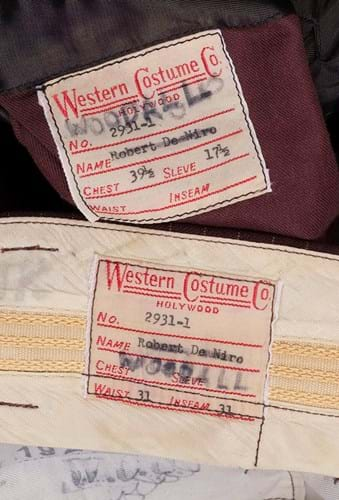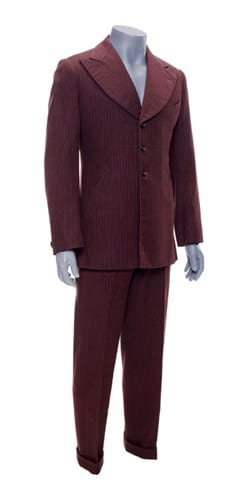1. The Godfather Part II suit – £50,000
This brown pinstripe woollen suit is one worn by Robert De Niro in his role as the young Vito Corleone in The Godfather Part II.
The costume, designed by Theadora Van Runkle, who received an Academy Award nomination for her design work on Francis Ford Coppola’s 1974 masterpiece, appears towards the end of the film when Vito Corleone returns to Sicily with his family.
In a famous scene, wearing this suit, he exacts revenge on local Mafia boss Don Ciccio (Giuseppe Sillato) for the murder of his father, opening his gut with a kitchen knife.

The labels on the suit worn by Robert De Niro in The Godfather Part II which sold for £50,000 at Propstore.
The costume carries the label of the Western Costume Co with the tag labels for De Neor and his waist size of 31in.
Offered with a guide of £10,000-20,000 at the Propstore sale of entertainment memorabilia in Rickmansworth on November 9, it took £50,000 from an internet bidder.
2. 17th century strong box – £30,000

Late 17th century arabesque marquetry strong box in the manner of Gerrit Jensen, £30,000 at Mellors & Kirk.
Like many English joiners of the period, not a great deal is known about the private life of Gerrit Jensen, a Flemish-born cabinetmaker who was working in St Martin’s Lane, London, from 1680 until his death c.1705.
However, as ‘Cabinet maker in Ordinary to the Crown’, Jensen's name appears frequently in the Royal accounts of the William and Mary period.
His workshop is the only one during this period known to have used metal inlays and elaborate ‘seaweed’ or ‘arabesque’ marquetry. Accordingly, his name is often linked with pieces such as this arabesque marquetry strong box or coffre-fort offered for sale by Mellors & Kirk in Nottingham on November 7.
Made in holly and, probably, rosewood and bound by elaborate brass strapwork, the interior includes a series of compartments veneered in prince's wood. These pieces, that would have been a costly purchase at the time (they were often sold with matching chests of drawers), are variously dated to the end of the reign of Charles II and the William III period (such as one in walnut made for Colonel James Graham of Levens Hall, Cumbria in 1688).
This example in Nottingham, on a giltwood stand of later date, was acquired by the owner’s father in the 1970s. Estimated at £4000-6000, it made a substantial £30,000.
3. Escher woodcut – $240,000

Coast of Amalfi (Composition), a rare 1934 woodcut by Maurits Cornelis Escher, $240,000 at Swann Auction Galleries.
Maurits Cornelis Escher (1898-1972) arrived on the Amalfi Coast in 1923 and ultimately created more than 100 works there based on the landscape. The seaside village of Atrani and the Collegiata di Santa Maria Maddalena cast a particular charm and inspired some of his most famous later works, most notably the series of Metamorphosis prints.
Escher painted and drew Atrani and its surrounding landscape from a number of different vantage points during his many visits.
Swann Auction Galleries’ November 2 Old Master Through Modern Prints sale in New York included a particularly rare woodcut. Titled Coast of Amalfi (Composition) it measured 70 x 74cm and dates from 1934.
The auction house described it as “a superb, dark and evenly-printed impression of an exceedingly scarce woodcut, with strong contrasts. We have not found another impression at auction in the past 30 years.”
Estimated at $20,000-$30,000, it hammered at $240,000 (£200,000).
According to Artprice, this is the second highest price at auction for an Escher print, next to the $600,000 bid at Sotheby's in April 2022 for one of the edition of 30 of Reptiles from 1943.
4. Chinese medallion bowls – £90,000
In Chinese symbolism, three goats shown together are representative of the New Year, bringing a change of fortune (sanyang kaitai). The perfect decoration for a Chinese New Year gift, this pair of Daoguang (1821-50) mark and period medallion bowls offered by Tennants in Leyburn on November 11 features such symbols prominently.
As medallion bowls these are top drawer. In addition to the finely painted vignettes to the imperial yellow ground with scrolling sgraffito decoration, they are internally decorated in underglaze blue with similar scenes of three goats beneath prunus branches. Another very similar example is in the permanent display at the Victoria & Albert Museum, London while others have sold at sales in London and Hong Kong for close to six-figure sums.
Tennants pair, in good condition, was guided at £30,000-50,000 and made £90,000.
5. Portrait of a poodle – £40,000

Sidi, a portrait of a poodle with a tennis racquet by Paul Friederich Meyerheim, £40,000 at Bonhams Edinburgh.
The artist of this 1898 oil titled Sidi is Paul Friederich Meyerheim (1842-1915), a German painter who chose animals as a subject after visiting the new Berlin Zoological Gardens as a boy.
Martin Lichtenstein, the zoo's founder, was so taken with his talent, he allowed him to access some of the ‘staff only’ areas.
This particular painting of a black poodle shows Sisi impishly holding an early lawn tennis racquet in its jaws. Dated 1898, the canvas was exhibited the following year at the Kunst-Ausstellung in Berlin, an exhibition Meyerheim helped organise.
In the word of canine art sentiment plays a significant part and this picture certain had the ‘ahh’ factory. The most eagerly-contested lot in Bonhams’ Dogs in Art sale in Edinburgh on November 8, hammered for £40,000 against an estimate of £6000-£8000.







